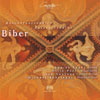Biber Mystery Sonatas
Inspired performances of Biber’s Marian sonatas
View record and artist detailsRecord and Artist Details
Composer or Director: Heinrich Ignaz Franz von Biber
Genre:
Chamber
Label: Coviello
Magazine Review Date: 3/2011
Media Format: Hybrid SACD
Media Runtime: 0
Mastering:
Stereo
DDD
Catalogue Number: COV21008

Tracks:
| Composition | Artist Credit |
|---|---|
| Mystery (Rosary) Sonatas and Passacaglia |
Heinrich Ignaz Franz von Biber, Composer
Daniel Sepec, Violin Heinrich Ignaz Franz von Biber, Composer Hille Perl, Viola da gamba Lee Santana, Theorbo Michael Behringer, Harpsichord |
Author: DuncanDruce
Are the Sonatas programme music? Daniel Sepec thinks so and his ideas about Biber’s descriptive intentions inspire his performance. Often these are persuasive – the fluttering of the Angel’s wings in the First Sonata (The Annunciation) or, in the Tenth Sonata (The Crucifixion), the hammering of nails into the Cross. His interpretation of the opening of the Eleventh Sonata (The Resurrection) as a sunrise is extremely poetic but I’m less sure about the deliberately ugly sounds in the Seventh Sonata (The Scourging of Jesus). In general, these are very fine-sounding performances. Sepec use three violins (to facilitate changes of tuning), all made by Jakob Stainer, known to Biber, and whose instruments were at one time valued even above Stradivari’s. The performances benefit greatly from the varied continuo group and often have a spacious, majestic character.
The Salzburg pitch seems to have been high in Biber’s time and I’d love to hear a recording that’s at, or above, modern pitch. But what emerges very clearly from these discs is the amazing range of Biber’s inspiration, brought out by playing that’s imaginative and deeply committed.
Discover the world's largest classical music catalogue with Presto Music.

Gramophone Digital Club
- Digital Edition
- Digital Archive
- Reviews Database
- Full website access
From £8.75 / month
Subscribe
Gramophone Full Club
- Print Edition
- Digital Edition
- Digital Archive
- Reviews Database
- Full website access
From £11.00 / month
Subscribe
If you are a library, university or other organisation that would be interested in an institutional subscription to Gramophone please click here for further information.




